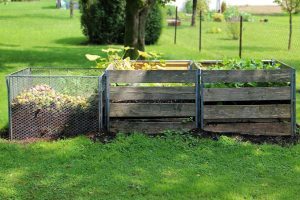
When did you last treat your grass with “brown gold” to keep it happy and resilient? MGG’s 2018 Spring Intern Ellicia Sanchez discusses the importance of compost.
Just like any house that requires a sturdy foundation to withstand rain, wind and other external pressures, your lawn needs healthy, organic matter to breathe, hold nutrients and water, and grow. Top-dressing your lawn with a thin layer of compost this June best provides that foundation.
Composting refers to the regulated disintegration of organic waste by microbes. By recycling natural nutrients from unused vegetable parts, grass clippings, leaves and other plant waste into the soil, compost dramatically improves soil structural and chemical quality.
All this organic matter creates a soil foundation similar to that of a sponge. Well-groomed compost has porous holes and abundant biotic life that absorbs extra air, water and nutrients. Soil scientists theorize that every 1% of added organic matter to an acre of soil that extends one foot deep, can increase the soil’s water holding capacity by 16,500 gallons. This mitigates lawn problems associated with poor drainage, including pests and weeds attracted to flooded areas.
Furthermore, composting reduces greenhouse gas emissions (GHG). Compostable materials decompose anaerobically at dump sites producing the highly potent GHG methane. In 2014 the EPA found that diverting 89 million tons of recycled/composted waste from the landfill caused an annual reduction in greenhouse gases equivalent to the annual emissions of over 38 million passenger cars. With all these benefits, no wonder some refer to compost as “brown gold”!
For creating your own compost mix, focus on compiling ingredients with an appropriate carbon-to-nitrogen ratio. “Green” inputs of grass clippings, vegetable peels and plant waste will contain nitrogen. Meanwhile, “brown” organic materials of hay, twigs and sawdust provide high concentrations of carbon. After decomposition these ingredients form into a balanced, nutrient-rich mixture for your lawn.
Compost with particle sizes smaller than ⅜ inches in diameter will benefit any lawn whether recently-seeded or established. Start by aerating your lawn to ensure the compost infiltrates the soil properly. Then, top-dress with a ¼ inch layer of compost. Following top-dressing, water your lawn immediately so that the mix spreads evenly between grass blades.
Composting has several indirect benefits that allow for an eco-friendly and strong lawn. The next time in the kitchen, think twice before tossing your vegetable scraps in the garbage. Consider the compost bin instead. Those “scraps” might create the lush, green lawn you’ve always dreamed
